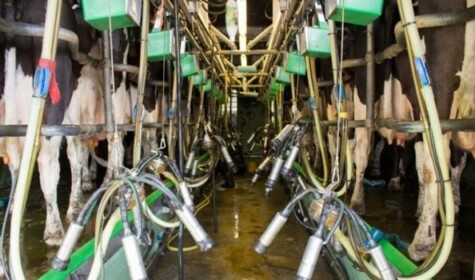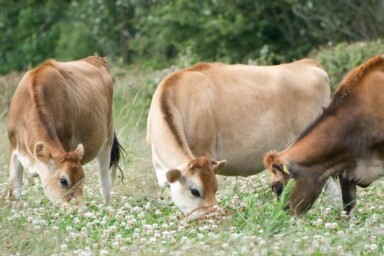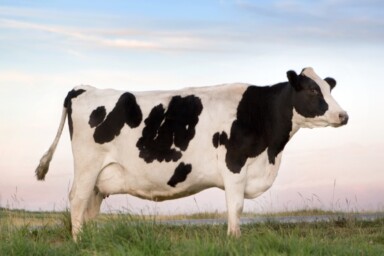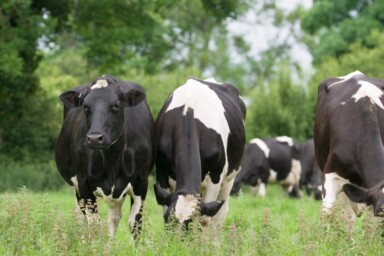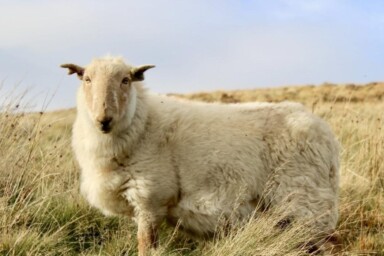Comments received online and by email, in response to Emily Franklin’s recent article Milk: The sustainability issue raised three questions about the use of soya in dairy farming, to which the SFT did not have ready answers. Richard Young has been investigating, and he’s come up with some unexpected facts.
Summary
UK Government statistics show that in 2015/16 total imports of soy beans, soy meal and soy oil totalled 3.1 million tonnes. Of this approximately:
- 1.1 million tonnes (35%) was fed to livestock,
- 1.42 million tonnes (45%) was used in food products for humans,
- 0.58 million tonnes (18%) was used in non-food products.
UK soy product imports were:
- Soy meal – 2.26 million tonnes
- Whole soy beans 0.68 million tonnes
- Soy oil – 0.16 million tonnes
- Only 400 hectares of soy beans were grown in the UK
Soy meal – 1.1 million tonnes (35% of total soy imports; 48.7% of soy meal) is fed to livestock (approximately 90% of it to pigs and poultry and farmed fish); 1.16 million tonnes is used as flour improvers, included in pet food and used in a wide range of industrial products including paint, pharmaceuticals and in the production and use of asphalt.
Whole soy beans – precise data are not collected, but the limited available information suggests that most of this is used in soy food products for human consumption, including flour improvers, soy milk/drink, whole soybeans for cooking and tofu.
Soy oil – close to 100% is for human use: 80% as refined soy oil, mostly then further modified (interesterified, or partially hydrogenated) vegetable oil in confectionary and other processed foods, 19% in biofuels, 1% in cosmetics and fly spray.
By financial value, soy meal exceeds that of soy oil. Only 11-18% (depending on variety etc.) of processed soy beans by weight is oil. However, the growing global human population has an ever-growing need for more soy oil and palm oil. Since humans use c. 100% of the oil (80% in food), it seems probable that any reduction in soy meal use in livestock would not result in a corresponding reduction in the area of land growing soy beans, unless it was accompanied by an even greater increase in palm oil production, than currently occurs.
In the UK, where a high proportion of feed for dairy cows comes from grass, approximately 60 litres of milk is produced for each kilo of soy meal fed to dairy cows. In the EU as a whole, approximately 30 litres of milk are produced for every kilo of soy meal fed. In contrast, only 7.5 litres of soy milk/drink is produced from each kilo of whole soy beans used.
Response to criticism of Emily Franklin’s article
I’ve never been a fan of soya being used in livestock feed and neither has the SFT, not least, because it is associated with the most intensive and damaging forms of crop and livestock production.
The huge environmental and social degradation problems in the Amazon, the Cerrado and other parts of South America where rainforest and other virgin land has been cleared to grow soya beans, are now well known, thanks to the tireless work of Greenpeace, WWF and others. Less well known are the facts that the vast majority of soya oil used in food is extracted from the beans using chemical solvents, such as hexane, residues of which remain in the end products, along with residues of nickel and aluminium, also used in the extraction process. In addition, of course, a very high proportion of soya is now grown using Roundup and genetically modified varieties, and whether you see GM crops as the saviour of civilisation or a disaster waiting to happen, the presence of Roundup residues in food, the WHO’s recent classification of Roundup as a ‘probable carcinogen’ and emerging evidence that even extremely low levels of Roundup in food could be harmful, inevitably raise additional issues that need careful consideration.
Summarising, the three questions posed (by the criticism of Emily’s article, because it did not mention the use of soya in UK dairy farming) are:
- How much soya is used in producing milk and other dairy products and what proportion of total soya use is this?
- Does producing soya milk use less soya beans than producing milk from cows?
- Is soya in livestock production the major driver of soya production, as we’ve been led to believe?
How much imported soya meal is used in dairy farming?
Defra’s GB animal feed – dataset (unavailable at the time of writing due to website redevelopment, but viewed and saved on 19 January) for imports of raw materials used in livestock feed, shows that the total amount of soya meal used over the last 12 months was 1,155,300 tonnes. Unfortunately, published statistics are not available to provide a breakdown of how much is used by each livestock species. In an email, however, Defra’s statistics department has told me that soya use in dairy cow feed in the UK accounts for 8-15% of the total, i.e. between 92,424 and 173,295 tonnes. That’s a very big range, so is there any way of narrowing this down?
According to Defra’s latest animal feed production statistics (published on 12 January 2017) 2,721,000 tonnes of concentrates and blends were fed to dairy cows in the year to November 2016. Based on previously published data, See Table 1 of this Defra report , we arguably need to add to this approximately 35,000 tonnes of protein concentrates (assuming a 50:50 split between beef and dairy) and 48,000 tonnes (25% of the amount fed to calves) to include heifer calves reared as replacements. This gives a total of 2.8 million tonnes.
Table 13 of a report published in 2015, ‘Mapping the soy supply chain in Europe’ by Hassel Kroes and Barbara Kuepper, estimates that on average concentrated dairy cattle feed across the EU contains 9.9% soya meal. This would equate to 277,200 tonnes of soya meal used in dairy farming in the UK, if this were also the case here. While it is instructive to see how much soya would be used if UK use of soya in milk production was as high as it is in the rest of the EU, this figure clearly cannot apply in the UK because it is over 100,000 tonnes higher than Defra’s top of the range figure of 173,295 tonnes.
There are a number of factors, which help to explain why we might expect use in the UK to be lower than the EU average:
- Due to the climate, the UK and Ireland are recognised as being more suited to grass production than any other EU countries. As such a higher proportion of milk will be produced from grass and a lower proportion from concentrates or other cereal-based feeds.
- In late April, May and June in the UK, when the grass is at its most nutritious, grazing dairy cows can maintain their own body weight from grass and produce up to 25 litres of milk per day without any concentrates. If they produce more than this then they need feeding for the extra milk at the rate of approximately 1kg of feed for every additional 3 litres of milk. In early April and from the beginning of July, production off grass will range between 15-20 litres, progressively declining into the autumn. Once the cattle are housed and receiving silage or hay they will typically produce only the first 10 litres from forage, but in years when the quality is very good this can be higher.
- For spring calving herds, the natural pattern of a cow’s lactation, with the rise in the milk yield for the first 3 months after calving and the steady decline thereafter over the next 6 months, largely follows the pattern of the milk that can be produced from grass, and means that during the summer months much less soya and concentrates generally are needed.
- Some UK dairy farmers use no soya meal at all. Patrick Holden, SFT chief executive, uses no soya to feed his organic dairy cows. Many other organic farmers also use little or no soya.
- A small number of producers marketing milk as pasture-fed, as certified by the Pasture Fed Livestock Association, use no grain-based feed at all, so they obviously also use no soya.
- There are other sources of protein that also get used in dairy cattle feed. These have a lower percentage of protein than soya but are especially suitable for use at times of year when there is a lot of protein in the grass. These include, lupins, rape meal and dried lucerne nuts.
There has, of course, been a trend over recent decades towards higher-yielding cows and more intensive, indoor production methods, as many dairy farmers have been forced out of the industry by very low farmgate prices for milk, sometimes well below 20p per litre. In order to survive, most of those remaining have had to cut their costs in any way they can and increasing herd size and intensification have been one of the major ways to do this. On more intensive farms which keep the cows on concrete for the whole of their lactation and feed high energy diets to achieve maximum milk yields, a higher proportion of the milk will be produced with concentrates than from cows on the remaining, more traditional, farms where the cows still go out to grass.
One possible way to get closer to the precise figure for dairy farming overall in the UK might be to use the percentages of soya used in the feed of other livestock species across the EU as a whole, also from Table 13 of the Kroes and Kuepper report, and multiply these by the tonnages of feed used in each species, then see how much is left for dairy cows. See table, here.
As can be seen, even without including any amounts for dairy cows, sheep, fish and other livestock types, the total is very close to the total amount of soya imported for livestock production. However, this cannot be correct since we know that somewhere between 92,424 and 173,295 tonnes is used in dairy farming. This indicates that overall the percentage of soya used in other livestock feeds must also be lower than the EU averages set out in Table 13 by Kroes and Kuipper in 2015, but we do not know exactly how much lower. A possible explanation for this is that recent changes to CAP rules which have forced all arable farmers to grow at least three different crops have increased the production of field (fava) beans and other protein-rich crops and these are being incorporated into livestock feed. The table suggests the totals are probably nearer the 8% end of the range than the 15% end, but the best I can do for now is to take the average 11.5% i.e. 132,595 tonnes, but recognise the amount could be higher or lower than this.
Soya milk or cows milk – which uses the most soya?
In comparison with cows milk, the commercial market for soya milk is quite small. Figures from AHDB Dairy show that in 2015/16, a total of 6 billion litres of cows milk, was marketed in the UK. This was made up of 4.8 billion litres of pasteurised cows milk, 286 million litres of filtered milk, 235 million litres of UHT milk and 7 million litres of sterilised milk. In contrast, only 86 million litres of soya milk was sold. There was also an unknown amount of soya milk produced by individuals in their homes.
It has been suggested, that making soya milk from beans rather than feeding soya meal to cows is more efficient in terms of soya use and therefore that more soya and less cows milk should be drunk in future. Let’s see what the evidence shows.
Producing soya milk from whole soya beans
According to various US recipes for making soya milk, a 7oz. cup of soya beans plus water will make 1.5 pints of soya milk. 7oz is almost 200g, so 1kg will produce 5 x 1.5 pints = 7.5 pints. Converting that to litres we get 4.25 litres.
1 tonne of soya beans turned into milk in the kitchen would therefore produce 4,250 litres. However, commercial producers of soya milk, are able to improve on yield efficiency. A food technology book published in 2006, ‘Soy Applications in Food’, by Mian N Riaz, tells us that one tonne of 37% protein soya beans produces 6,800 litres of 3.4% soya milk. The book also states that with a ‘two-stage decanter process’ the yield can be increased by a further 10%. I have no idea what proportion, if any, of soya milk is produced in that way, but if it all was, the yield would then increase by 680 litres to 7,480 litres. If you produce soya milk with less protein you can increase the yield further, but as cows milk typically contains about 3.4% protein let’s use that figure. This is approximate 7.5 litres of milk per kg of whole soya beans.
The use of soya meal in producing milk from dairy cows
There’s a relatively simple way to undertake this calculation. In addition to the 6 billion litres of liquid milk sold (from which a large amount of butter is also produced), additional data from AHDB Dairy shows that the UK also produced 441,284 tonnes of cheese in the year to November 2016. I make a farmhouse cheese from time to time by a very traditional and time-consuming method, just for family use and it needs approximately 10 litres of milk to produce each kilo of cheese. On that basis, to make 441,284 tonnes of cheese you need another 4,41 billion litres of milk. Some cheeses such as brie require only about 7 litres of milk per kilo and cottage cheese even less. But these account for only a very small share of the market. There are statements in various publications online suggesting 11 billion litres was produced in 2014, so we’re in the right region, but let’s keep it at 10.4 billion because production could have fallen.
We can therefore say that somewhere in the region of 10.4 billion litres of milk was produced last year from between 92,240 and 172,950 tonnes of soya bean meal. 10,400,000,000 divided by 92,240,000 kilos is 112.7 and by 172,950,000 kilos is 60.1.
Calculation conclusions
On the basis of these calculations, cows milk comes out significantly better than expected with:
- Between 60 and 112 litres of milk produced for each kilo of soya meal fed to cows,
- 7.5 litres of milk produced from each kilo of soya beans turned into soya milk
With the soya milk the edible soya by-product okara is also produced. But with the cows milk only soya meal and about 0.2% oil is used, as opposed to whole beans for the soya milk which contain both the meal and the oil. That adds another 11-19% efficiency to the cows milk. This may only balance out the benefits associated with the production of okara. But the very large amount of butter also produced from cows milk gives it an additional advantage in the comparison with soya milk. Soya milk is lower in fat than cows milk and this is claimed to be a benefit, but in reality, those consuming soya milk are likely to take an additional share of the soya bean oil or palm oil for vegetable spreads to compensate for the fact that no butter or vegetable spreads are produced in the making of soya milk.
EU comparison
In Table 19 of their report, Kroes and Kuepper calculate that throughout the EU 7g of soya is used to produce a 200 ml glass of milk. That’s 35g for 1 litre, which works out at 28.6 litres per kilo of soya. The difference can be explained by higher use of concentrates due to less abundant grass growth, but I have insufficient information to make a proper assessment. However, this does also provide evidence of why keeping cows on grass is better for the environment than keeping them on concrete and why, despite its shortcomings the UK dairy sector should be supported. If UK milk production did not match demand dairy products would be drawn in from other countries, most of which would use more soya per litre produced than UK farmers, due to our natural advantage in relation to grass. This should be borne in mind as the UK seeks to develop new global trade deals.
However, none of these calculations actually answer the specific question of how much milk comes from soya, and essentially it’s an impossible question to answer, since there are other sources of protein that can be used. What they do show, however, is that the use of soya on dairy farms is much lower than I assumed, and probably lower than most people assume. We can also see, from the table that chicken production is by far the biggest user of soya meal.
What is driving the ever-increasing production of soya beans?
All this, however, as I have found to my surprise, is less than half the soya story. In her article, Emily Franklin cited a WWF report which claims that 75% of soya is fed to farm animals. I’d never questioned this, but the evidence suggests this is seriously misleading, in relation to the UK, at least. Data from HM Customs and Excise show that in 2015/16, almost 2.26 million tonnes of soya meal was imported into the UK in total. Like most people I’d assumed most, if not all, soya meal was fed to livestock.
My initial reaction was that there must be a mistake, however, further digging has highlighted the fact that the rest (1.1 million tonnes) is used in a very wide range of food and industrial products. A Defra report lists these other uses which include: baby foods, bakery products, beer, cereals, diet foods, pet foods, adhesives, antibiotics, ashphalt emulsions, cleaning materials, cosmetics, inks, leather substitutes, water-based paints, plastics, polyesters, pesticides and textiles.
In addition, a further 684,000 tonnes of whole soya beans and 160,000 of soya bean oil are also imported. A very small proportion of the beans would have been for planting the 400 hectares of soya beans grown in the UK in 2016, see this Farmers Weekly article on Soya UK’s website. While whole beans appear predominantly to be used for human food, soya oil use, like use of the 1.1 million tonnes of non-livestock feed soya meal, is split between food and industrial uses. The exact spit between these uses is unrecorded, but evidence from a variety of sources suggests that for the oil (the more valuable of the three products) 70-80% is used in processed foods and cooking oil, the rest in industrial uses including biodiesel.
Of the 3.1 million tonnes of soya products imported into the UK we can therefore conclude that 37% (1.1553 million tonnes of soya for livestock) is fed to farm animals, whereas 63% (1.94 million tonnes) is more directly used by humans, either in food or industrial products. And while 8-15% of the soya imported for livestock is fed to dairy cows, expressed as a percentage of all soya imports this falls to approximately 3-5% of all imported soya.
Yet even this doesn’t take account of imported pork and chicken. The UK imports 25% of the chickens consumed and 45% of the pork consumed. Adding in the soya used to feed them increases the total by 250,000 tonnes, bringing the total used to produce livestock products that are consumed in the UK up to 42% while the total used directly in food and industry comes to 58%.
While we have all been led to believe that livestock production is the key driver of increased soya production, because demand for meat keeps increasing, the evidence, as far as the UK is concerned, suggests the situation is far more complex than that.
Given that 70-80% of soya oil is used in foods and on average everyone, meat-eaters, vegetarians and vegans alike, get 36% of their daily energy from fats and oils, if there were no uses for the meal, the oil would still be needed. If there was no soya production, then even more rainforest would need to be destroyed in SE Asia or central Africa to increase the production of palm oil still further. The only durable solution to the twin problems associated with both soya and palm production (as well, perhaps with coconut oil), would be to recognised the huge mistake that was made in turning away from animal fats, and set about changing production systems to produce healthy animal fats with a low omega-6 to omega-3 ratio, which is easily achievable if a high proportion of cattle and sheep diets were to come from grass). Allowing pigs and cattle to put on more fat before slaughter and feeding them more natural diets (the exact opposite of trends over the last 30 years), could also greatly reduce the nation’s dependency of fats from rain forests on the other side of the planet, to which, in addition to the environmental costs in the country of production, the environmental costs of shipping, not included in national greenhouse gas inventories, also needs to be added.
But whatever you make of that argument, my main point isn’t that it’s fine to be feeding lots of soya to livestock, it is that by pretending that livestock production is the main driver of soya production, we are failing to face up to the far bigger issues of population growth and economic growth, which are the root causes of the soya problem.
More complete statistics would allow the calculations, above, to be refined. We welcome comments, additional statistics, corrections and revised calculations from anyone with an interest in these issues and/or a better understanding of them.
[1] Defra does not publish data on how much feed is used on UK fish farms. I asked where I could find this data and was told they do not publish data on the amounts of feed produced by individual companies. Based on a previous battle in relation to obtaining data on how much of a particular antibiotic was used, which took a strong public interest case, 3 years of correspondence and determined help from the information commissioner to win, my understanding is that this means there are only one or two major manufacturers of fish feed in the UK and Defra doesn’t release the total data as rival companies could then calculate how much was being produced by their commercial competitors.
Summary and minor edits added 25th April 2018
